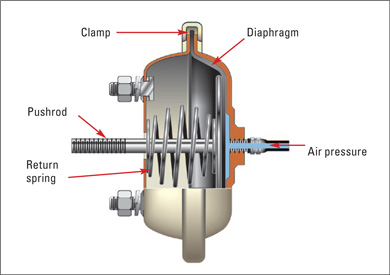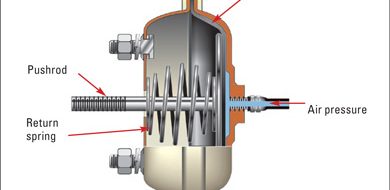Air brakes are found on large diesel powered motor homes. Many states and provinces require the driver have a special endorsement on their driver’s license to operate an air brake equipped vehicle. So, why is an endorsement needed and do people really need a course covering this topic?
The answer is yes, mainly driven by the fact that some owners have no idea how they work or if they are operating correctly. Secondly, for safety and cost effective maintenance, every air equipped owner could benefit from fully understanding today’s air brake systems.
There are two brake actions; service brake function and park brake. The regular service brakes are applied using air pressure. The park brake is spring action applied.
The service brakes are divided into two separate systems, one to operate the front brakes and the other for the rear. This provides braking should one system fail. Pushing the brake pedal operates a pneumatic valve that sends air pressure to the air chamber at each wheel. A diaphragm within the chamber moves an adjustable rod that mechanically applies the brakes via a “S” cam.
The park brake on the drive axle of a diesel pusher is spring powered and is housed in an additional chamber that is attached to the back of the brake chamber. It has a diaphragm that, when air pressure is introduced, holds the spring back. This is a safety feature; if all air pressure is lost, the park brakes automatically apply.
Now some operation tips.
*If the park brake is engaged, do not use heavy foot pressure on the brake pedal, as the combined force of both the spring and that of the air pressure may over stress the brake components. Fortunately, there are anti-compounding valves in all modern systems that reduce this risk. But, following this procedure is always prudent.
*Pretty well all modern diesel pushers have automatic slack adjusters, thereby alleviating this chore. However, it is the owner’s responsibility to verify that their system is operating correctly. Regularly check the following:
1) The air pressure takes no more than 3 minutes to go from 50 PSI to 90 PSI at a near idle engine speed.
2) At operating pressure, release the park brake, shut the engine off and make a full brake application. Observe the pressure gauge while holding the brakes on for one minute. No more than a 3 PSI pressure drop should occur.
3) Fan (Continuous brake applications) brake pedal to reduce pressure. At about 60 PSI the warning device should sound. Further reduction to about 25/45 PSI, the park brakes should apply signalled by the knob popping out.
* If you need to have your vehicle towed, you need to supply continuing air pressure to the system or “Cage” the brakes (using a threaded rod into the back of the spring chamber to hold the spring in a compressed state).
* Test park brake by trying to move vehicle while it is engaged.
If any of this is foreign to you, get an air brake operators book that covers all the tests at your local book store. It is interesting and might one day save your life.






Pingback: 150 Year Old Technology Still Stops Big Vehicles - Here's How Air Brakes Work - Mortons on the Move
Peter Mercer
I think it would be the right step to have all air brake operators learn about their braking system. A basic test, as now happens in those locations, should be mandatory for all. Thanks for your input.
Peter Mercer
I think all braking systems are complex. Air braking systems may seem more complex, but probably due to them not being on the general vehicles we use daily throughout our lives. For this reason and more, some states and provinces require special endorsement to operate them. Thanks for your interest in the topic.
Anonymous
Good sam is a must and laws are are in place for our safety,do yourself a favor and learn your air brakes.it wont hurt you to miss one sports game in order to find time to know your rv.
Anonymous
I appreciate the information on what you should know about air brakes. I had no idea that air brakes were so complicated and that there were so many things you had to look out for when it came to air braking. I would imagine that air brakes need to be maintained very meticulously to ensure that they are working correctly.